Pocky and Rocky Reshrined: the Digital Foundry tech review
The retro remake redefined.
Retro game remakes are tough to do well - in addition to making old games playable on modern hardware, you've also got to understand the intent of the original creators to keep the spirit of that game alive, especially if you're looking to produce a proper remake rather than a mere remaster.
Perhaps that's what makes Pocky and Rocky Reshrined, a 2D scrolling action game for Switch and PS4, so compelling: it was developed by the same core staff that created the SNES version of Pocky and Rocky 30 years ago. As such, it goes way beyond a typical retro remake, preserving the action and aesthetics of the original title while significantly expanding its length and breadth. Reshrined is also a shining example of a Unity game done right on a technical level - more or less, anyway.
The journey from Super NES to modern platforms was a long one for developers Tengo Project, beginning in 1986 with an arcade game known as Kiki Kaikai. Created by Taito, Kiki Kaikai is an overhead run and gun shooter rooted in Japanese mythology. Its core game design resembles Capcom's Commando from a year prior, but its unique themes and twist on that formula results in something truly magical. Following its release in arcades, it would receive multiple ports but remained an exclusive to Japan - until 1992, when a home console focused sequel was produced for Nintendo's Super NES. It follows the same basic design of the arcade original but features far more scenario variation and creative level design pushing the concept further. It's also the first entry that would be released in the West under the title Pocky and Rocky - but unlike the arcade game, this one wasn't developed by Taito at all. It was simply licensed out to, and developed by, Natsume's internal Japanese development team.
During this era, Natsume quietly produced some of the very best action games ever. This includes games such as the seminal Shatterhand, Shadow of the Ninja for NES, two Pocky and Rocky games, The Ninja Warriors Again and Wild Guns - with the same three key members behind Tengo Project being involved in most of these releases. In the modern era, the squad's first game as Tengo Project arrived in 2008 with the Xbox Live Arcade exclusive Omega Five, a horizontal shooter with a remarkable soundtrack. Around a decade later, the team had produced two reimaginings of its past works, with Wild Guns Reloaded in 2016 and The Ninja Warriors Once Again in 2019. Tengo Project became the masters of revisiting games they had previously worked on while perfecting the formula with new features, an improved presentation and more. While simple in concept, the execution is superb with some of the best pixel art, music and design for games of this style.
I'm happy to report that the remake of Pocky and Rocky excels in the same way - and might also be the team's most ambitious re-creation yet. Like the original, Reshrined is effectively a run n' gun shooter played from an overhead perspective. You begin the game as the shrine maiden Pocky, while making your way through each stage taking out foes along the way. The initial available mode is a story mode which asks you to take control each of the various characters with story sequences dividing up the stages. Once completed, however, you can also jump into free mode allowing you to select any character you've unlocked and play through the game in two player mode without any interstitial scenes.
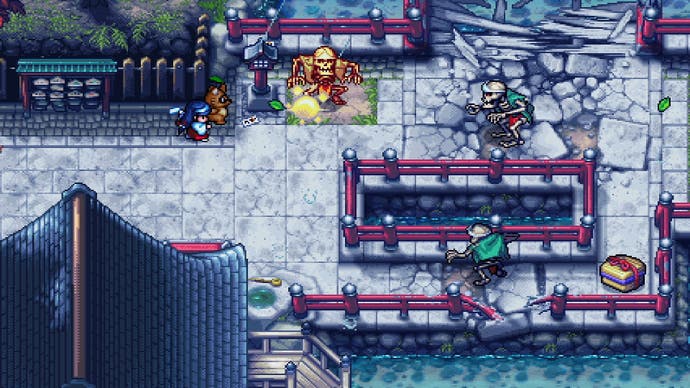

What makes this an ambitious remake? Well, it begins by recreating the Super NES original with greatly enhanced, higher-resolution pixel art. Without the constraints of memory and storage, the team is able to push the visuals, absolutely packing them with detail and life.
Beyond this though, individual sections of the game's stages have been dramatically altered, with different landscapes, altered enemy patterns and new phases for boss fights. And after the first stage in the game's story mode, things begin to change even more - instead of continuing as Pocky, you'll take control of her tanuki companion Rocky and explore vastly different levels. There are moments when the paths of the original and Reshrined will cross, but much of the game is a completely new series of stages. Eventually, you'll reconnect with some of the stage concepts from the Super NES game but the actual level design itself is radically altered. As a result, it winds up feeling more like a new game that borrows some elements rather than a typical remake. It's really great stuff.
And just like Ninja Warriors and Wild Guns before it, Pocky and Rocky has hidden depth that makes it an exciting game to play and replay. Initially, you'll find that shooting while dodging projectiles is the name of the game, but you're quickly overwhelmed - making it tough to complete even the first stage. This is where the nuance comes into play - you'll soon discover that your melee attack not only vanquishes enemies, it also destroys and reflects enemy projectiles. This becomes a key early strategy that is further enhanced by the addition of a dash move with invincibility frames and a bomb. Later in the game, you'll gain other abilities as well - all of these stack to create a game that really rewards skilled play. Together with quick, responsive controls and superb presentation, making your way through the game is very satisfying.
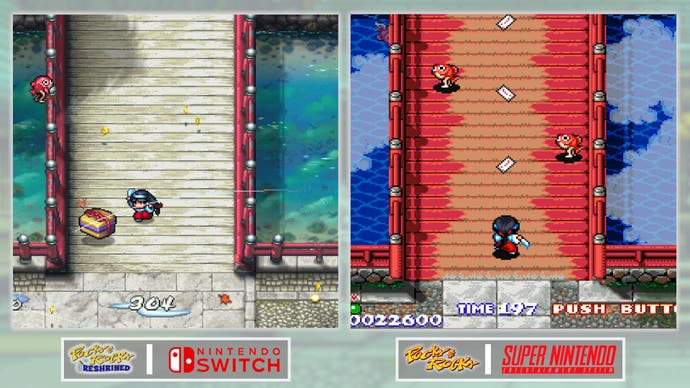
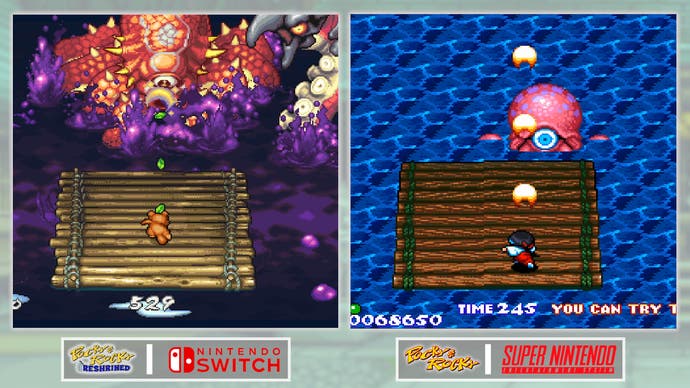
From a DF perspective, beyond the actual game here I also find the way in which Tengo's games are developed completely fascinating. The three key members of Tengo Project are continuing on from games they produced under the Natsume label for decades, and it's so rare to see old-school game development persisting into the modern era. You can genuinely say that these guys are still making games like it's 1991. Of course, this style of development never really disappeared, thanks to the rise of indie games, but it's great to see these legends continue to hone their craft 30-something years later.
Of course, Tengo have also fully embraced modern tools in building their games - like its prior two releases, Pocky and Rocky was created in Unity. In that sense, I feel their work is a true showcase of what's possible with 2D pixel art in a modern engine - they manage to avoid nearly every pitfall that so many other Unity games have fallen into, delivering something that feels remarkably authentic and polished from top to bottom.
That includes simple things, like ensuring that the art perfectly adheres to the pixel grid structure and that none of the visual effects feel out of place, to taking advantage of its extra capabilities to push interactivity forward - right from the start, you'll notice leaves on the path, which flutter away as you dash over them.
Curiously, the game's menu does include scaling and scanline options for those interested. The scanline option even introduces slight color separation at its higher value, simulating the look of red, green and blue phosphors. Personally, I found that this filter was effective in portable mode but wasn't really necessary when playing on the TV. The default scaling fills the screen, and the aspect ratio looks correct, but it is slightly wider than the art itself - so if you look closely, you might observe minor shimmering during scrolling, but I do feel this sharp, nearest neighbor scaling is the best option and vastly preferable to, say, linear blurring.

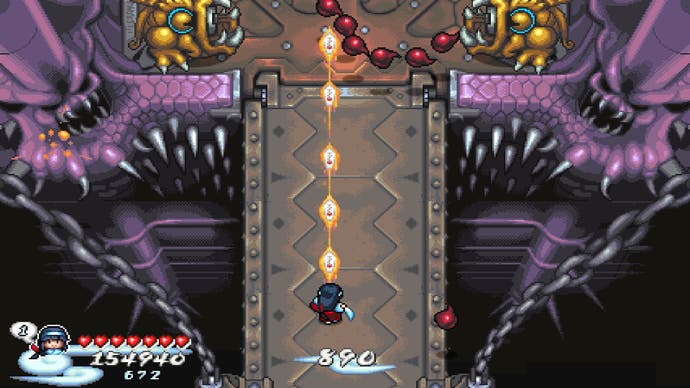
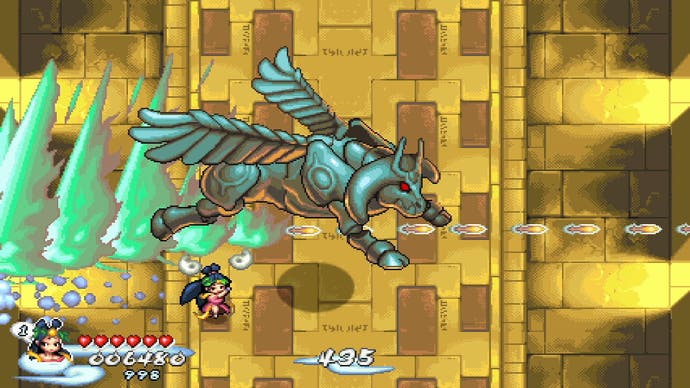
As it stands, the game is currently available on Nintendo Switch and PlayStation 4 - it was released in Japan very recently, which is the version I imported, but it is arriving in the West this June both in digital and physical form.
So which version do you choose? I mentioned earlier that the game makes great use of Unity, sidestepping many common issues, but it's not quite flawless on Nintendo Switch. Essentially, the game has some slowdown during gameplay - it's always targeting 60fps but it's not able to sustain this at all times. Having finished the game on Switch, I will say that it's not as bothersome or frequent as I had expected, but it's worth noting. I didn't have the PS4 version available for capture but I checked out footage of the game running and it seems to clean up these issues. So if you're looking for the best performance, I'd recommend going for PS4. It's also worth considering, however, that both versions actually run smoother than the SNES original, which has plenty of slowdown throughout! Thankfully, these minor dips are the only real technical hiccup here - loading is minimal, controls are responsive, and everything looks fantastic. It's especially a treat when paired with the Switch OLED.
So that's my take on the Pocky and Rocky series and Tengo Project as a whole. If you couldn't tell, I adore this series - and Tengo Project is one of my favourite developers around today for their amazing work on bringing such games back to modern platforms. The amount of passion and skill poured into each game never ceases to impress. If you're into 2D action games like this I honestly can't recommend it enough - Pocky and Rocky Reshrined is a special game. If you're new to the series, give yourself a little time to adapt to the controls and design and, eventually, it will click.


